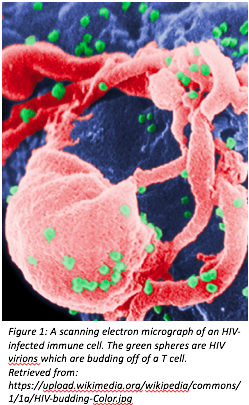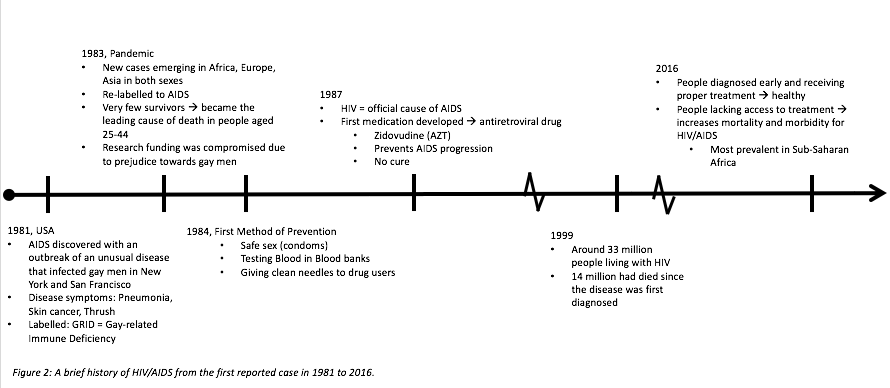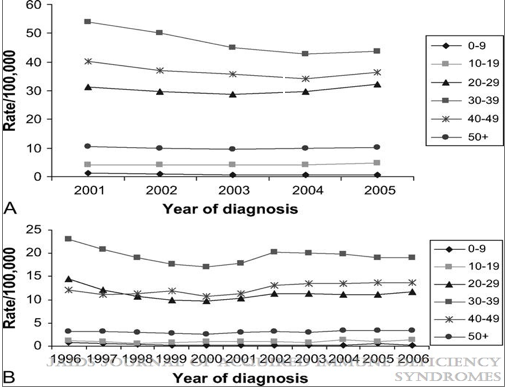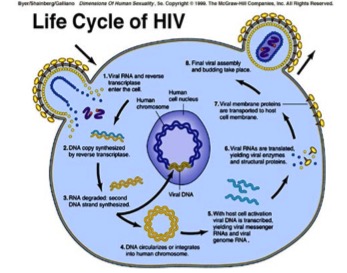This is an old revision of the document!
Table of Contents
Human Immunodeficiency Virus/Acquired Immune Deficiency Syndrome
Human Immunodeficiency Virus, or HIV, is a retrovirus that causes AIDS, or acquired immune deficiency syndrome. It does this by infecting immune cells in the body, specifically CD4+ T cells, making the infected host vulnerable to infection. Without proper treatment of HIV, AIDS can take up to 8 years to develop, which can make diagnosis difficult (Sharp, 2011).
Introduction
Origins
HIV has two known strains, HIV-1 and HIV-2. The strain that is most commonly associated with AIDS pathogenicity is HIV-1. These strains originated from the Simmian Immunodeficiency Virus, or SIV, which initially infected several primates in Africa. Through cross-species transmission, several genetic modifications were made to SIV, allowing it to infect humans, leading to the classification of HIV (Sharp, 2011).
Once in the human population, the incredible pathogenicity of the virus allowed it to turn into a pandemic eventually killing millions of people around the world. It is thought that Hunters in West Africa were exposed to infected blood in primates, and initially contracted the virus. After this, through international travel and changes in patterns of sexual behaviour, the virus was able to transmit into several areas in the world (Sharp, 2011).
History of HIV/AIDS
<style justify>
In 1981, AIDS first broke out in the US amongst gay men in New York and San Francisco. They were initially classified as having a mysterious pneumonia-like disease that presented with a rare from of skin cancer, thrush, and other characteristic symptoms. Since this was highly prevalent in gay men, the name for this disease was called GRID, or Gay-related Immune Deficiency (Holland, 2013).
In a matter of 2 years, AIDS became a pandemic. This was largely due to the fact that funding regarding research pertaining to gay men, a group that was highly discriminated against at the time, was difficult to attain. This halt in research gave the virus time to spread across the world, such as Africa, Europe, and Asia. More importantly, the disease was found to be prevalent in both sexes, which contradicted the initial theory that gay interactions lead to the disease, and so it was re-labelled to AIDS. Unfortunately, AIDS became the leading cause of death in people aged 25-44, however, this statistic accelerated research surrounding the disease (Holland, 2013)
Since finding a cure to AIDS was incredibly difficult, the goal was shifted to AIDS prevention. In 1984, the first method of prevention was established based on the finding that AIDS was transmitted through mucosal membranes, and blood transfusions. This included safe sex (especially the use of condoms), testing blood in blood banks, and giving clean needles to drug users (“A Timeline of HIV/AIDS”, n.d).
By the late 1980s, HIV was officially labelled as a retrovirus that causes AIDS. After this, anti-retroviral drugs were created and administered. One of these drugs was called zidovudine, or AZT. This prevented AIDS progression, rather than providing a cure (Holland, 2013).
However, despite advances in AIDS therapy, the majority of people suffering from AIDS did not have proper health care or access to treatment. The region with the highest prevalence of AIDS was in Sub-Saharan Africa. By 1999, around 33 million people, including women, children and men, were living with HIV. Since the first reported case of AIDS in the 1980s, around 14 million people had died (“Global HIV/AIDS Overview”, 2016).
Today, testing methods for AIDS are quick, and easily determined which allows for early diagnosis. These people must continue to take anti-retroviral therapy for the rest of their lives to prevent AIDS progression, but they can live healthy lives. However, there are still a large proportion of people, especially in Sub-Saharan Africa, who do not have access to either prevention methods (like safe sex), or anti-retroviral treatment (Holland, 2013).
Currently, 36.7 million people are living with AIDS, 1.8 million of cases are in children. Since the start of the epidemic, 35 million people have died. However, the number of people receiving treatment drastically increases every year, with 17 million people receiving anti-retroviral treatment this year, which is 10 million higher than the statistic 2 years ago. Of the total pregnant women suffering from HIV, 77% of them are being treated, and there has a 50% decline in the rate of incidence in newborns, which again, is a huge advancement (“Global HIV/AIDS Overview”, 2016). A summarized version of the timeline can be seen in Figure 2 (below).
</style>
Epidemiology
<style justify>
National surveillance systems in Canada and the United states have been used to observe the trends in AIDS and HIV. In 2005 AIDS diagnosis rates in the United states were substantially higher in blacks, followed by hispanics and then caucasians. In Canada, the AID diagnosis were higher for aboriginal peoples, then blacks, and substantially lower for caucasians. (Figure 1) In both countries the trend was seen that HIV diagnosis increased for men who were having sex with men, and in general men were diagnosed at substantially higher rates than women. (insert figure 2 ) The age group with the highest rate of diagnosis was 30-39. (insert figure 3)
It is seen that 54 % of United State diagnosis and 64% of Canadian diagnosis were found late in the disease process. Overall diagnosis rates have been stable and not decreased in recent years. There is a need for prevention efforts in order to reduce the diagnosis rates in ethnic minorities, as well as men who have sex with men.
Figure 3: Rates of HIV diagnosis by age, 33 US states (A) and Canada
Brain: Cocaine effects the brain by causing blood vessels in the brain to constrict, which can therefore lead to a stroke. This is a common consequence of chronic cocaine use, even in young adults without other risk factors for strokes. Cocaine can also cause seizures and can lead to violent behaviour.
Lungs: The methods that are used to take this drug can cause damage to the respiratory system. Snorting cocaine damages the nose and sinuses. Smoking crack cocaine irritates the lungs and for some people it can lead to permanent lung damage.
Kidneys: Cocaine use can cause severely overwhelming kidney failure through a process called rhabdomyolysis . Users with high blood pressure that use cocaine regularly can accelerate the long term kidney damage caused by high blood pressure.
Sexual function: Chronic cocaine use can impair sexual function in men and women. In men, cocaine can cause delayed or impaired ejaculation.
Gastrointestinal tract: Cocaine can cause constriction in blood vessels supplying the gut. Therefore resulting in oxygen starvation which can cause ulcers or perforation of the stomach or intestines.
</style>
Mechanism of Action
Viral Structure
<style justify>
HIV is a type of RNA virus that is enclosed by a phospholipid envelope. The surface of the virus contains protrusions consisting of 3-4 GP41 glycoproteins, which are then capped by GP120 glycoproteins. The GP120 proteins are what will bind to the receptors of immune cells to allow viral infection of HIV. Within the envelope of the virus, there is a protein nucleocapsid, which surrounds two single stranded RNA molecules as well as enzymes important for viral functioning. These enzymes include reverse transcriptase, protease and integrase. Reverse transcriptase is used to create a DNA molecule from an RNA template. Protease is involved in the cleavage of proteins, which allows for activation of the HIV virus. Finally, integrase allows viral DNA to be inserted into the host cell’s chromosome (Berger et al., 2016).
</style>
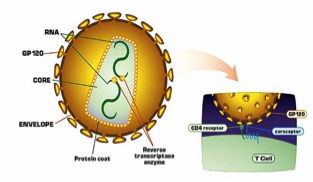 Figure 4: Structure of viral HIV. Retrieved from: https://learner.org/courses/biology/units/hiv/index.html
Figure 4: Structure of viral HIV. Retrieved from: https://learner.org/courses/biology/units/hiv/index.html
HIV Life Cycle
<style justify>
The HIV virus first gains entry into the host cell where it is able to stimulate certain signaling cascades that assist in viral replication. Specifically, HIV attacks CD4 immune cells, which are a type of white blood cell that protects the body from infection. HIV viral cells have two molecules attached to its’ surface, GP120 and GP41 cells. GP120 binds to CD4 receptor cells; this causes conformational changes and spore formation that allow the virus to gain entry into the CD4 immune cells. Once in the cell, the viral genome is released and it is reverse transcribed into DNA by the viral enzyme, reverse transcriptase. The viral genome is then inserted into the host chromosome via the viral enzyme integrase. The DNA is transcribed and translated into proteins and exported out of the host cell via the vesicular sorting pathway. These new HIV viral particles are immature and noninfectious; therefore it cannot infect another cell (Simon, Ho & Karim, 2006). However, once the noninfectious HIV has left the host CD4 cell, the HIV releases protease, which breaks up longer protein chains within the noninfectious virus, thus forming the mature and infectious form of HIV (AidsInfo, n.d.).
</style>
Figure 5: Life Cycle of the HIV virus. Retrieved from: http://nigeriahivinfo.com/wp-content/uploads/2015/10/hiv-virus-life-cycle.jpg
Progression to AIDS
<style justify>
HIV will continue to proliferate within the body at low levels for many years. This chronic form of HIV will eventually become AIDS (acquired immunodeficiency syndrome). The progression of HIV to AIDS typically takes approximately 10 years or more, depending on the course of treatment. HIV damages the immune system so severely that the body is unable to fight off infections and the patient is thus diagnosed with AIDS. An individual must have a CD4 count of less than 200 cells/mm3 and/or have one or more opportunistic infections in order to be formally diagnosed with AIDS. Opportunistic infections are characteristic of individuals with extremely weakened immune systems and they are often associated with end stage HIV/AIDS (AidsInfo, n.d.).
</style>
